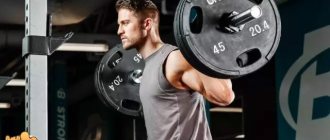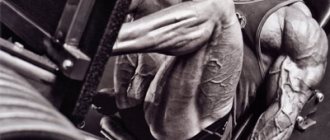Four day split is a training program for the gym designed to gain muscle mass and increase the athlete’s strength. A four-day split can be used by athletes of different skill levels, but the program and its goals will vary. Beginning athletes who have already completed the preparatory stage of 2-3 months, switching to the split system, can use this program to train all their muscular and non-muscular qualities in a state super compensation. Intermediate athletes can use a four-day split to bulk up and increase strength in large muscle groups while dedicating a training day to training the shoulders and arms. Advanced athletes can use a four-day split to specialize in a specific muscle group.
The four-day split has a number of advantages that allow you to easily increase the volume of each workout and provide the opportunity to use such progressive training methods as stretching . The disadvantage of the program is that you have to spend more time and more effort on it, in the sense that you have to approach it even more responsibly than a three-day split, because if the athlete violates his diet, sleep, or, moreover, allows himself drink, then he will not have time to recover for the next workout. As a result, the schedule will go wrong, you will have to take a step back, reduce the load and take a whole series of measures just to get back on track. Therefore, before starting this program, you need to answer the question of how ready you are to use it!
What is split training
Split training is a way to create a highly effective program in which 2-3 muscle groups are worked out in one session. Moreover, in this mode there is an opportunity for complete rest and the best recovery. So, for example, if we consider the classic triple split, which is essentially a division of the body into three parts, which are worked out on different days during the week.
With such training, each group has the opportunity to recover for a week. For example, if an athlete does legs on Monday, then the next time he will train legs on Monday. Also, with this training strategy, you can successfully alternate, add and combine exercises or experiment with combining muscle groups.
Drawing up and options for four-day splits[edit | edit code]
This article was written for those who are no longer satisfied with the results of three-day splits, or for those who have decided to diversify their training process. A four-day split is a logical continuation of three-split training systems. The difference is that four workouts are carried out in a weekly cycle, during which all muscle groups of the body are worked out. Since there is one more workout in the cycle, you can pay more attention to working out various muscle groups. There are many options for creating four-day splits. Since there are five main muscle groups, and there are only four workouts in a cycle, usually training one of the small muscle groups is added to the training of a large muscle mass, or some group (for example, arms) is divided into several components (biceps and triceps), each of which he trains on different days after working out other muscle groups. For example, biceps after the back, triceps after the chest or deltoids. Or biceps after the chest, and triceps after the back. Or the deltoid heads are trained each on their own day. A four-day split is most often performed using the 2+1+2+2 system, i.e. two workouts in a row, then a rest day, then two more workouts and two days of rest. After which the split starts all over again. There are other systems of four-day splits, for example 1+1+1+1+1+1+1, that is, training takes place every other day, only there is no rest day between the last and first training. In addition, there are four-day split systems with a different number of days in the cycle, for example 2+1+2+1 - a six-day cycle, or for example 2+2+2+2 - an eight-day cycle for a four-day split. Below are options for several four-day splits, in addition to which you can develop many others based on your own needs and preferences.
Option 1[edit | edit code]
- Monday: back, triceps;
- Tuesday: legs;
- Wednesday: rest;
- Thursday: chest, biceps;
- Friday: deltoids;
- Saturday: rest;
- Sunday: rest.
Option 2[edit | edit code]
- Monday: back, rear deltoid;
- Tuesday: chest, middle delta;
- Wednesday: rest;
- Thursday: legs;
- Friday: hands;
- Saturday: rest;
- Sunday: rest.
Option 3[edit | edit code]
- Monday: back, hamstrings;
- Tuesday: chest, legs;
- Wednesday: rest;
- Thursday: quadriceps, deltoids;
- Friday: hands;
- Saturday: rest;
- Sunday: rest.
Benefits of a split program
According to scientists and sports doctors, muscle hypertrophy is a long-term process. On average, the growth of muscle fibers after a single intense load continues for two or even three weeks. In this case, training designed to work all muscle groups in one workout actually inhibits the development of skeletal muscles and, naturally, reduces the effectiveness of training. By the way, such training will quickly lead to exhaustion of the body. The athlete’s body will spend all its energy on recovery, the growth phase will not start.
Split training allows you to efficiently work out specific muscle groups during a workout and recover effectively during the allotted time for rest, that is, until the next workout. Split training is best for gaining muscle mass.
Nutritional Features
When split training, as with any other, it is necessary to follow the principles of a healthy diet and use healthy foods as a source of energy. Of course, under the influence of the load, the muscles will become stronger, regardless of your nutrition. But excessive consumption of sweet, fried and fast food will make these changes insignificant and poorly noticeable.
The nutrition program is adjusted depending on the goals of the training, as well as the time of training. If your goal is to lose weight, you need to be especially careful. In this case, it is necessary to reduce the caloric content of the diet and maintain the correct proportions of fats, proteins and carbohydrates.
Compliance with the principles of proper nutrition is especially important for girls, as their body accumulates fat deposits faster and takes longer to build muscle tissue. A proper nutrition program and regular exercise help adjust your metabolism and set your body up for the desired changes.
We must not forget the importance of water. On training days, your rate increases. If you usually drink 2 liters of water per day, you will need approximately 2.5 liters during exercise.
Who is suitable for split training?
Split training is suitable for athletes who have a certain athletic level, when training for all muscle groups becomes insufficiently effective. Split training is also perfect for bodybuilders who deeply work each muscle using different training methods and a whole range of exercises. But this type of training should not be recommended for beginners until the body has adapted to physical activity. And the amount of load that split training provides is also useless for beginners or athletes after a long break in training.
Basic plan for beginners
Goal : strengthening the core muscles, preparing for further work in the gym.
Purpose : for those who have just come to bodybuilding, or have minimal experience in the gym. The program will help tone your body and improve physical performance. Basic exercises promote fat burning, so the plan is suitable for weight loss.
Features : minimum additional equipment. If you have dumbbells, you can practice at home.
The first day:
- twisting;
- pushups;
- dumbbell press up;
- dumbbell chest press;
- bent over arms;
- plank
Second day:
- “diamond” push-ups;
- bending the arm over the knee;
- bench push-ups for triceps;
- press one dumbbell with both hands behind your head;
- arm extension with body tilt;
- bending one arm while sitting.
The third day:
- deadlift;
- sumo squat with weight between legs;
- Bulgarian lunges with weights;
- lunges with walking forward;
- pelvic bridge with dumbbells on the stomach;
- lowering the heel down while standing on the steppe (for the lower leg muscles).
Fourth day:
- dynamic bar;
- side plank with a dumbbell in one hand;
- raising arms through the sides;
- Arnold press;
- swing forward;
- shrugs.
All exercises are performed 3-4x15 times. The plank should be done in three approaches of one minute each. The weight of dumbbells for beginners is 5-6 kg. The program is very easy, you don’t need to stay on it for long. 10-12 regular workouts are enough and you can move on to the next stage.
The right approach to split training
- You need to start with training for all muscle groups. You need to practice in this mode for at least one to two months. During this period, training is a set of basic exercises and linear cycling of training is used. It is divided into 4 stages, but we will not dwell on this, since this is a separate large topic.
- After this phase, the training process can be transferred to a two-day split training. This phase can last from several months to six months. Basically, basic exercises are used at this stage.
- The next stage will be a three-day split. This program is a classic of sorts. By the way, another feature of split training is the alternation of different exercises and muscle groups in the first and second weeks. This prevents the body from getting used to the load and adapting to the exercises, which makes the training more effective.
- In addition to the three-day split, there is also a four-day and a five-day split. Such options allow you to further increase the load and work out specific muscle groups more effectively. With such training, the number of approaches and exercises for each muscle group increases. Typically, four and five day splits are used by professional athletes or athletes using hormonal anabolic drugs. The training uses both basic and isolation exercises. Athletes of average training level do not need this type of training at all and will not give the desired result.
- It is also worth adding that in split training mode, you can work out either synergist muscles, for example: pectoral muscles, anterior deltoid and triceps, or antagonists - chest and back muscles, biceps and triceps in one session. Read more about antagonist and synergist muscles →
- High-level athletes can split their leg workouts into quads and soleus, and then hamstrings and calves.
When to practice?
Training 4 times a week is a serious challenge for a beginning athlete. It is important to structure the week in such a way as to fully work out all muscle groups, but at the same time leave time for normal rest of the body and nervous system.
The main principle from which to build is that large muscle groups need 60 to 72 hours to recover. The large groups are the lats and upper back, pecs, buttocks and thighs. Thus, at least 2.5 days must pass between the load of these zones. But small groups recover much faster - from 24 to 48 hours, so biceps, triceps, deltoids and abs can be worked out much more actively, even every other day.
There are three schemes for such classes:
- 4 workouts in a row, 3 days rest;
- 2 days – work, 1 day rest, 2 days work and another 2 days rest;
- 3 workouts in a row, 2 days of rest, 1 lesson, 2 days of fasting.
The most convenient and correct way is training 2 through 1. This scheme is suitable for a full four-day split, since different muscle groups are loaded on training days 1 and 2.
4 or 3 classes in a row also have a right to exist, but only with a competent approach. Here it is important to accurately calculate the speed of recovery of muscle groups in order to be able to work out the body well and not burn out due to constant stress.
A four-day split without rest days is not recommended for beginners. A person who has not played sports before may encounter a number of difficulties when choosing such a program:
- constant fatigue;
- heavy load on the nervous system;
- injuries;
- burnout;
- slow progress.
In the first two months of training in the gym, it is recommended to choose a three-day basic program to prepare the body for further muscle hypertrophy. If you already have some experience, you can try a four-day program, but you should be prepared for the fact that after 3-4 weeks you will experience a loss of strength.









